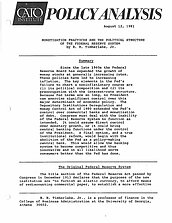Monetization Practices and the Political Structure of the Federal Reserve System
Since the late 1960s the Federal Reserve Board has expanded the growth of money stocks at generally increasing rates. These policies have led to increasing inflation. The key elements in the Fed’s failure to chart a noninflationary course are (1) its political composition and (2) its preoccupation with the interest-rate structure. Because Fed terms are so long, no President can exercise significant control over this major determinant of economic policy. The Depository Institutions Deregulation and Money Control Act of 1980 extended the Fed’s control over commercial banks and monetization of debt. Congress must deal with the inability of the Federal Reserve System to function as intended. It could assume direct control over monetary growth, or it could bring central banking functions under the control of the President. A final option, and a true institutional reform, would begin with the abolition of the Fed as a policy-making central bank. This would allow the banking system to become competitive and thus innovative and in all likelihood serve consumers better than the Fed has done.

This work is licensed under a Creative Commons Attribution-NonCommercial-ShareAlike 4.0 International License.

